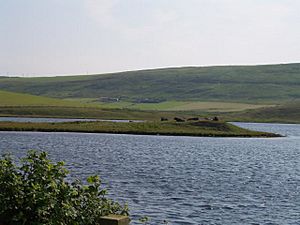Law Ting Holm facts for kids
| Meaning of name | flat island of the parliament |
|---|---|
| OS grid reference | HU416427 |
| Coordinates | 60°10′01″N 1°15′04″W / 60.167°N 1.251°W |
| Physical geography | |
| Island group | Shetland |
| Area | <1 ha |
| Highest elevation | <5 metres (16 ft) |
| Administration | |
| Sovereign state | United Kingdom |
| Country | Scotland |
| Council area | Shetland Islands Council |
Law Ting Holm, also known as Tingaholm, is a small piece of land in the freshwater Loch of Tingwall. This loch is located on Mainland Shetland, Scotland. It used to be a tiny island completely surrounded by water. A stone path, about 1.7 meters (5.6 feet) wide and 42.7 meters (140 feet) long, connected it to the shore. In the 1850s, the water level of the loch was lowered. This changed the island into the piece of land we see today. The Loch of Tingwall is west of Lerwick. It also has another island called Holm of Setter.
Contents
Where Shetland's Old Parliament Met
Law Ting Holm was a very important place for Shetland's local parliament. This parliament met here until the late 1500s. Records show that meetings took place in Tingwall as early as 1307. However, the first time we hear about the parliament meeting on the holm itself was in a letter from 1532.
How the Parliament Meetings Worked
It was common for these meeting places to have a special mound. This mound might have been made from handfuls of earth. Each handful came from the different local areas represented at the meeting. This way, everyone could feel like they were on their "home ground."
Today, you can still see a small, worn-down mound on Law Ting Holm. The remains of a wall were also found around the edge of the island. This suggests that a private area was created for the meetings. It was typical for parliament sites to be places where discussions could be seen but not easily overheard. The stones where the "Ford" (a type of official) and other leaders sat were reportedly removed in the 1700s. This was done to create more space for animals to graze.
Changes to the Meeting Place
In the 1570s, Earl Robert Stewart moved the parliament to nearby Scalloway Castle. However, Law Ting Holm was used one more time in 1577. On that day, over 700 Shetlanders came to complain about a local official named Lawrence Bruce. They brought their complaint before royal commissioners from Edinburgh.
In 1774, a writer named Low reported that the stone seats had been pulled up. This was to make more room for grazing animals. But in 1809, Edmonston suggested that you could still see where a stone table and bench had been on the holm.
Archaeological digs in 2011 found remains of an old settlement from the Late Iron Age. This was at Law Ting Holm. However, they didn't find clear proof of later parliament activities. Still, other finds show that the stone path (causeway) was kept in good condition even into the 1800s.
Other Ancient Parliament Sites
Parliament assembly sites, often called "Thing" sites, are found all over Northern Europe. This is because of a shared Norse (Viking) heritage. You can often spot them by their names, which include words like thing, ting, ding, or fing.
Examples of Thing Sites
- Þingvellir in Iceland
- Tinganes in the Faroe Islands
- Tynwald Hill in the Isle of Man
- Fingay Hill in England
- Dingwall in Scotland
Tingwall is just one of many "ting" names found in Shetland. Other parish names like Sandsting, Aithsting, Delting, Lunnasting, and Nesting suggest that there were once many local parliament sites across the islands. Some old names like Gnípnaþing, Þvætaþing, and Rauðarþing are also found in old documents, but these places are no longer known by those names.
The THING Project
Law Ting Holm is part of an international project called the THING Project. This project explores and promotes the shared history of these ancient parliament sites in Northern Europe. It includes partners from Iceland, Norway, the Faroe Islands, Orkney, Shetland, Highland Scotland, and the Isle of Man.
The project aims to develop new ways for businesses and tourism to grow in these areas. For example, in 2011, delegates met in Dingwall to discuss making these sites part of a transnational World Heritage Site. This would be an expansion of Iceland's existing World Heritage site at Þingvellir.
Wildlife Around Law Ting Holm
The Loch of Tingwall is home to various birds. You might see Tufted ducks, red-breasted mergansers, and different types of gulls, including common and black-headed gulls. The loch is also special because it's the only place in Shetland where mute swans live.
Law Ting Holm in the Arts
The Royal Scottish National Orchestra (RSNO) performed a new music piece called Tingaholm in Lerwick on March 4, 2012. This composition was written by Chris Stout and named after the historic parliament site.


